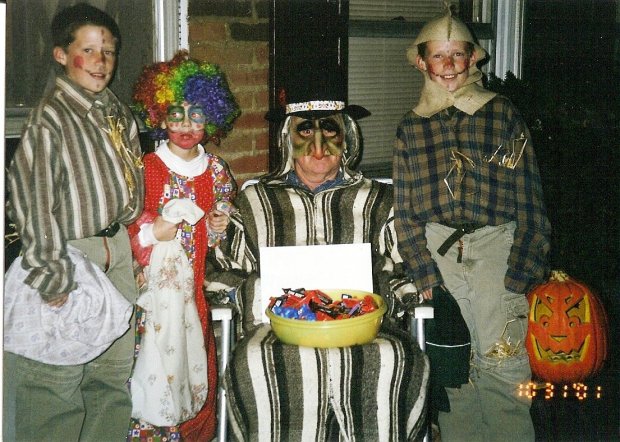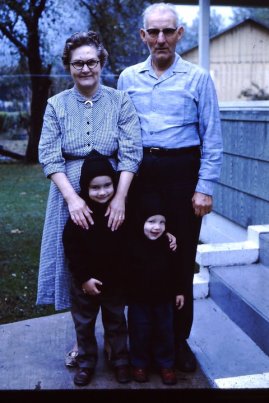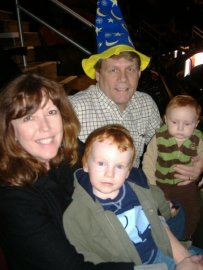Archive for September, 2011
Standard work: New Ideas are not necessarily better.
Posted by valuesstreamldr in Organizational Silos on September 23, 2011
Welcome Fall! My favorite time of the year brings the memory of the story below that really drives home the essence of the waste of over-processing. It also demonstrates poor alignment around a vision. It also serves as a good lesson on the need for standard work. In fact, there are many lean, life lessons in it.
Just because an idea is new, doesn’t necessarily mean it is better. Vetting a suggestion through the use of a robust (not cumbersome) review process, leads to the implementation of proven and consensed upon changes before changing the current standard and leading to unintended consequences.
New standards, if misaligned with the vision as recounted below, result in process improvement gone wild or a tale of unintended consequences. Enjoy.
Saint Francis and Grass Lawns
author: Unknown
“Winterize your lawn,” the big sign outside the garden store commanded. I’ve fed it, watered it, mowed it, raked it and watched a lot of it die anyway. Now I’m supposed to winterize it? I hope it’s too late. Grass lawns have to be the stupidest thing we’ve come up with outside of thong swimsuits! We constantly battle dandelions, Queen Anne’s lace,
thistle, violets, chicory and clover that thrive naturally, so we can grow grass that must be nursed through an annual four-step chemical dependency.
Imagine the conversation The Creator might have with St. Francis about this:
“Frank, you know all about gardens and nature. What in the world is going on down there in the Midwest? What happened to the dandelions, violets, thistle and stuff I started eons ago? I had a perfect, no-maintenance garden plan. Those plants grow in any type of soil, withstand drought and multiply with abandon. The nectar from the long-lasting blossoms attracted butterflies, honey bees and flocks of songbirds. I expected to see a vast garden of colors by now. But all I see are these green rectangles.”
“It’s the tribes that settled there, Lord. The Suburbanites. They started calling your flowers ‘weeds’ and went to great extent to kill them and replace them with grass.”
“Grass? But it’s so boring. It’s not colorful. It doesn’t attract butterflies, birds and bees, only grubs and sod worms. It’s temperamental with temperatures. Do these Suburbanites really want all that grass growing there?”
“Apparently so, Lord. They go to great pains to grow it and keep it green. They begin each spring by fertilizing grass and poisoning any other plant that crops up in the lawn.”

“The spring rains and cool weather probably make grass grow really fast. That must make the Suburbanites happy.”
“Apparently not, Lord. As soon as it grows a little, they cut it – sometimes twice a week.”
“They cut it? Do they then bale it like hay?”
“Not exactly, Lord. Most of them rake it up and put it in bags.”

“They bag it? Why? Is it a cash crop? Do they sell it?”
“No, sir. Just the opposite. They pay to throw it away.”
“Now let me get this straight. They fertilize grass so it will grow. And when it does grow, they cut it off and pay to throw it away?”
“Yes, sir.”
“These Suburbanites must be relieved in the summer when we cut back on the rain and turn up the heat. That surely slows the growth and saves them a lot of work.”
“You aren’t going believe this Lord. When the grass stops growing so fast, they drag out hoses and pay more money to water it so they can continue to mow it and pay to get rid of it.”
“What nonsense! At least they kept some of the trees. That was a sheer stroke of genius, if I do say so myself. The trees grow leaves in the spring to provide beauty and shade in the summer. In the autumn they fall to the ground and form a natural blanket to keep moisture in the soil and protect the trees and bushes. Plus, as they rot, the leaves form compost to enhance the soil. It’s a natural circle of life.”
“You better sit down, Lord. The Suburbanites have drawn a new circle. As soon as the leaves fall, they rake them into great piles and have them hauled away.”

“No! What do they do to protect the shrub and tree roots in the winter and keep the soil moist and loose?”
“After throwing away your leaves, they go out and buy something they call mulch. They haul it home and spread it around in place of the leaves.”
“And where do they get this mulch?”
“They cut down trees and grind them up.”
“Enough! I don’t want to think about this anymore. Saint Catherine, you’re in charge of the arts. What movie have you scheduled for us tonight?”
“Dumb and Dumber, Lord. It’s a real stupid movie about…”
“Never mind I think I just heard the whole story.
Grandpa, tell me ’bout the good old days.
Posted by valuesstreamldr in Family on September 11, 2011
Today is a special day for many reasons. We are going to my daughter’s house to celebrate my oldest grandson’s 4th birthday. When he was born, I remember thinking that I was not worthy of the title “Papa Pettry”. My grandfather owns that title. My father is called “Papa Johnny” by my children. “”Papa Tim” just doesn’t sound right to me, so just plain “Papa” will have to do. As we celebrate the growth of our next generation, we will also take time to remember the events of September 11, 2001 and the sacrifices and memories of previous generations.
September 11th will forever be a day of remembrance for those of us who watched in horror in 2001 as our world changed in front of us. It forced all of us to question what was important in our lives and served, at least for me and my family, as a point of gathering closer together, seeking comfort in each other.
My family comes from humble beginnings in the coal country of West Virginia. Both of my grandfathers worked in the coal mines to support their large families. Eight kids in my father’s family, ten in my mother’s. That’s a lot of aunts, uncles and cousins. I’ve been blessed with a large extended family.
Last year, another tragedy occurred in the coal mine where my Grandfather worked. The mine in Montcoal, W.V. exploded taking the lives of 29 miners. It put the town of Montcoal on the global map. This, however, was not the Montcoal that I remembered.
In anticipation of my parents’ 50th wedding anniversary in 2007, I asked my father for the 8 mm videos that he had taken while we were growing up. I was able to convert the films to digital files and then create updated videos of my parents, their families and friends, and my siblings and their families. It was a joy to work on these and I watch them frequently.
Putting music to the raw 8mm videos resulted in a one hour montage of my youth. After the mine explosion, I shared the linked video of my favorite segment on YouTube, to show Montcoal in better times. (click here to see video). It is special because it includes both of my grandfathers and my great-grandmother.
Memories of the struggles that those before us have endured are what keep me moving forward. Their hard work made my life easier. Creating new memories with those who are following me is a joy and I hope that my hard work translates into a better life for them.
We need to occasionally pause to mourn the loss of our innocence, and we must never let the sacrifices of those who have gone before us go unrecognized or be forgotten. We must also work harder to create and capture new, happy memories for those who are following us.
Happy birthday, Natey Bee! Love, Papa.
An EPIC (Engine Plant In Cleveland) story
Posted by valuesstreamldr in Lean Principles, Shingo, Systems, Tools, Uncategorized on September 9, 2011
Working at Ford in the early 1990’s, I had the privilege of learning about lean manufacturing from some of the best lean thinkers at the time. Looking to develop and implement a production system, Gifford Brown, our plant manager, sought the assistance of key ex-Toyota Georgetown powertrain leaders.
Russ Scaffide, John Allen, Dwight Clark and Bill Costantino joined the Cleveland Engine Plant 2 (CEP2) team as consultants and helped author and implement what was then called the Cleveland Production System.
The Cleveland Production System (CPS) became the forerunner to the modern Ford Production System (FPS), and its implementation at CEP 2 led to the plant being recognized with the Shingo Prize for Excellence in Manufacturing in 1996.
My role (as a cost analyst at the time) in the development of the CPS, in addition to taking the handwritten model and creating the slide above, was to proof-read the documents that were created. I was new to manufacturing, however, my prior background at what was then Ernst & Whinney‘s National Marketing headquarters in Cleveland, included conducting secondary market research on potential client companies, their industries, officers, directors and our competitors. We used this data to support the writing of major audit and management consulting proposals, which we were also responsible for proof-reading – a valuable skill that I’ve used to learn as much as I can throughout my career.
Proof-reading the early documentation of the CPS gave me the opportunity to learn about this new way of thinking in manufacturing and because I had less to un-learn, I was able to pick up on the concepts quickly and contribute to the discussion.
The model – and its implementation – with Ford and UAW leaders responsible for jointly championing and teaching the individual elements, served as a visual reminder of our responsibilities. Our role was to take all of these lean tools, systems and principles and create value for the customer through continuous process improvement and the identification and elimination of waste.
Attending the initial training, then eventually becoming a trainer for the system, there was one thing that always bothered me about the model. The model placed itself at the center, rather than the customer. Our model seemed to put all of its weight on top of the customer and never seemed quite right.
I sought to reconfigure the model as a “Focus within a Framework”. I placed the customer at the center of the model, and then built the framework with the “pillars” of the system – People, Added Value, Just-in-Time, and Performance Measurements. Once the focus was placed within the framework, I then used the elements of the production system to create the web. As our plant was a supplier to Ford assembly plants around the world, I used the (new at the time) catch phrase “Worldwide Web” to attract the attention of attendees at a joint Ford / UAW quality conference in Dearborn in 1996.
My use of a spider’s web as an analogy for a production system came from several places. First, my favorite bedtime story to read to my kids was E.B. White‘s Charlotte’s Web. In the story, Charlotte, a spider, weaves words into her web to describe Wilbur, a runt pig who is in constant fear of being slaughtered as he fattens up. Charlotte seeks to save Wilbur by pointing out his better qualities in such “web posts” as “Some Pig“, “Terrific”, “Radiant” and finally “Humble”. I started to view a production system much like a spider’s web. (I’ll discuss the irony of the word “Humble” being the word that finally saved Wilbur in an up-coming post.)
The other influence on my spider thinking came from a student who I was supervising in my first job out of college at a major retail store. She was working in the evening and when asked about getting stock out of the storeroom and onto the shelves, commented “if it wasn’t for the customers, I would be able to get my work done.” This view of the customer as a nuisance fit nicely with the transformation in thinking required to move from mass (where the customer is sometimes viewed as a nuisance) to lean, (where the customer is nourishment).
In my web analogy, the contrast between the way that humans view flying insects as a nuisance and the way that spider’s view flying insects as nourishment emerged. In fact, a spider’s existence is dependent upon its ability to capture and hold onto insects that move in and out of its “Window of Opportunity”. Much like customers’ disposable income should be viewed as the lifeblood of any organization.
If the spider’s web doesn’t cover the entire opening, potential nourishment can fly through without being captured. If the web breaks, the ability of the spider to quickly react and fix the problem directly impacts the spider’s future viability.
An organization’s leaders are responsible for identifying the organization’s Window of Opportunity, providing a focus on the customer, and creating the systems that enable employees to create value to capture and hold onto customers. Quick reactions to breakdowns and weaknesses in the systems when identified, are necessary to maintain organizational stability and provide continued growth.
Principles – the focus and the framework of any organization – linked through systems and tools enable employees to create and provide increasing value to customers. Thus, our “Window of Opportunity” defines how well our Principles connect to our customers and our ability to create value through the continuous improvement in our systems and tools and the identification and elimination of waste.
Continual assessment of the effectiveness of our systems and adjustments when and where necessary will determine the amount of nourishment we receive.
Unfortunately, the model, which I found attractive and intuitive, never caught on as the CPS morphed into the FPS. However, the learning I obtained from creating it and thinking through all of the various messages it conveys have helped me as a frame of reference when assessing other lean organizations. It was especially helpful the following year when I moved to Cleveland Engine Plant 1 to implement the new Ford Production System in a plant that was in a slightly different emotional state. I’ll share that story in my next post.
Are you capturing your customer’s disposable income that is moving in and out of your Window of Opportunity? Are your systems complete and connected? Do you react quickly to signals your customers are sending, indicating their presence in your window? When your systems are weak or broken, do you respond immediately to minimize the loss of potential customers? Do you view your customers as a nuisance or nourishment?
The U.S. Air Force Thunderbirds and other high-performance teams.
Posted by valuesstreamldr in Shingo, Teamwork on September 2, 2011
As I sat working in my office, my attention was diverted by the sights and sounds of the Air Force Thunderbirds practicing for this weekend’s National Air Show in Cleveland.
From the Press Release announcing their performance,
“The six select Thunderbird pilots will put their distinct red, white and blue F-16 Falcon jet fighters through a choreographed hour-long performance each day at speeds up to 500 mph and as close as three feet from each other. The Thunderbirds are the U.S. Air Force “Ambassadors in Blue” and represent the United States at approximately 35 sites both home and abroad each year.
The Cleveland National Air Show is a Labor Day Weekend family tradition and one of the largest annual events on the North Coast.
Watching these planes maneuver around the buildings of downtown Cleveland and out over Lake Erie inspires awe at the union of pilots, planes and teamwork. To hear their sound and feel their power as windows and ground shake demands your attention and respect.
I had the good fortune of being a member of the Shingo Prize Site visit team in 1999 that visited the Lockheed-Martin manufacturing facility in Fort Worth, TX where the F-16 Falcon jets come to life. It was a treat to observe the interaction of design engineers, process engineers and assembly line workers transform a bunch of metal, wires and other assorted parts into a finished jet fighter as it traveled down a one-mile long assembly line. 
Not only was the facility a great place to see, but the team of examiners gathered to assess the organization was one of the best I’ve had the pleasure of working with. The team’s co-leaders were George Koenigsaeker, a 2010 inductee into Industry Week’s Manufacturing Hall of Fame and Ross Robson, former Executive Director of the Shingo Prize and Shingo Prize Academy member. Also on the team was Larry Anderson, Lean Gold Certified, past Chairman and co-member with me on the AME/ASQ/Shingo Prize/SME Lean Certification Oversight and Appeals committee. It was truly a high performance team and quite a learning experience for me.
Describing teamwork is a lot like defining quality. The statement “I know it when I see it” applies. However, it doesn’t go deep enough to fully understand the work and dedication required behind the scenes to make the visible product satisfying to both customer and team member.
Achieving, then maintaining high performance is hard work and comes with few shortcuts. Members of high-performance teams receive their reward from the purpose of their work, the satisfaction from their interactions with each other, and ultimately the outcome of their dedication.
What high-performance teams have you been a part of? What are some other examples of high-performance teams that are well-known? What characteristics would you use to describe a high-performance team?
Enjoy your Labor Day weekend!









